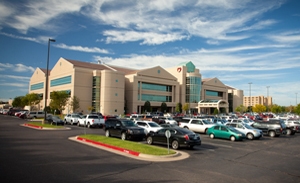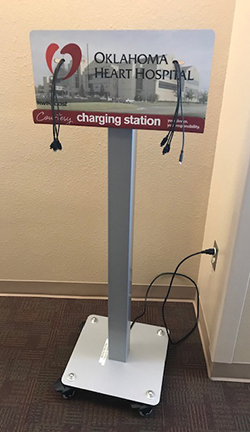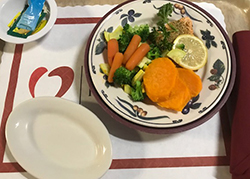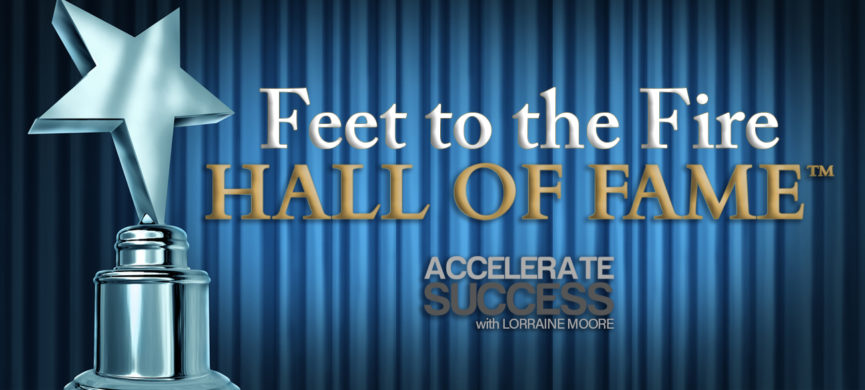I am pleased to recognize Oklahoma Heart Hospital (OHH) as the next inductee into the Feet to the Fire Hall of Fame™.

After researching several US hospitals, we selected Oklahoma Heart Hospital for my husband’s quadruple bypass. As Canadians, we paid in full for the procedure up front. When you do so, particularly with the current foreign exchange, excellent care is the number one priority, but compassionate, thorough care provided by professionals with a high level of expertise is equally important.
Oklahoma Heart Hospital hit it out of the park. It is evident that they have a culture of accountability.
They demonstrate a high level of expertise and are very thorough.
The day before the surgery, our surgeon had reservations about proceeding the next day due to some newly identified risks. While my husband, Peter, was very disappointed with a potential delay, we were equally impressed with how thoroughly Dr. Jeffrey Garrett investigated the risk. He consulted with at least two other esteemed colleagues, including a vascular surgeon. As he was in surgery that afternoon, we met with one of those colleagues and had a thorough discussion before the surgeons consulted again and made a final decision. And that surgeon who met with us late in the afternoon, stayed after his appointments that day to give us time to return to the hospital and meet with him.
While in ICU, Peter had a nurse at his bedside 24/7. I was on one side of the bed and his nurse was on the other. While he does not remember, every time he moved his hand, turned his head or shifted, particularly while on a ventilator when he could not communicate verbally, the nurse responded and spoke to him. I never saw the nurse leave the room. If they needed something, they would walk a few paces to speak to someone at the nurse’s station. Most CCUs have a ratio of two patients to one nurse. What I observed was that not only his physical status and health, but also his emotional state, were considered and attended to quickly.
They are open to innovation, even when it may disrupt their typical routine or practices.

Before Peter entered the operating room, I met Dr. Eric Carter, a physician from Tampa, Florida. Eric is the brainchild behind the DocClocker app. When his father had cardiac surgery, he and his mother found the wait agonizing while his father was in the OR. That was the impetus for this app that provided me updates directly from the OR, every 30-60 minutes. Does this add to the tasks of an OR nurse? Of course, it does.
What differentiates OHH is that they were willing to pilot this app because it greatly improves the family member experience. I knew when the surgery commenced, the steps that were completed, that my husband was stable (what you most want to hear), that all was going well, that the surgeon was happy with the results, when the surgery was nearing completion, and what room he would be in and who his nurse would be. Some families in the waiting room received a video of the procedure underway. I discussed this after with my husband. He would not want to see that if it was me in surgery. I would have been interested. But of the two of us, I am the one who will opt for local anesthetic and a conversation with the doctor, while Peter is happy to be out.
The communication through this app was particularly powerful for me, as I was some distance from home, in a new city, without any friends or family members. It reduced my anxiety while he was in surgery, and I was able to proactively provide updates to friends and family who were cheering for us from a variety of cities.
They instill a level of confidence.
It is an anxious time when someone you love is undergoing major surgery and even more so when you are away from the familiar and one’s support system. For the days that Peter was in the hospital, I had a sense of calm. I could see the diligence in the care leading up to and following the surgery, and I felt confident that if any complications arose, they would be addressed quickly and with a high degree of expertise and experience. When Dr. Garrett consulted with Dr. Tom Hennebry and another surgeon before making the final decision to operate the next day, I saw a professional who recognized his infallibility and was confident enough to seek out a second and third opinion.
They demonstrate a high level of collaboration and coordination.
When we arrived at the clinic for final tests and a consultation with the surgeon, everyone we interacted with had our information readily accessible and greeted us by name. When we arrived for surgery, the concierge desk (their term) greeted us, and every stage of the prep was well coordinated, with little waiting or downtime. Our appointments at the clinic both before and after surgery, and the surgery itself, all started earlier than scheduled as we were present and ready. Results from X-rays and other diagnostic procedures were available within 10 to 15 minutes, not hours as we are accustomed to.
“We take pride in what we do,” one of the surgeons told me. This is apparent as everyone demonstrates accountability for the client experience.
Anyone who saw us – standing in a hallway, waiting for an appointment, in line for coffee – greeted us with a smile and asked if we needed any assistance. Most of the time we did not, we were simply going for a stroll or stretching our legs. Physicians and nurses asked on multiple occasions if there was anything we needed and asked if they were meeting our expectations.
Actions match words at OHH.
I believe this is because the implementation is aligned with the strategy. If the goal is to provide great health care at a reasonable cost that generates profitable and sustained returns for the physician owners and referrals from customers/patients and families, the actions are aligned.
Following my husband’s diagnosis, we adopted a plant-based diet, as decades of research support the health benefits. When he was admitted to a different hospital for a cardiac episode some weeks ago, his request for no dairy, no meat, no oil, no caffeine (he has never been a coffee or tea drinker) resulted in a meal tray with one rice cake, apple sauce and instant coffee (in spite of his request for no caffeine) – hardly any nutrients and certainly insufficient caloric intake. The gap between taking care of oneself and the tools with which to do so was pretty big in that instance. There is a direct correlation between diet, lifestyle and health outcomes. How could that meal tray support anyone’s more rapid recovery? Shorter hospital stays go right to the bottom line. They also reduce waiting times and provide a better patient outcome.

Contrast this with OHH. Dr. Garrett is also a proponent of a plant-based diet. He has seen sufficient evidence to support the health benefits. At OHH, the meal service is called room service. It is not putting lipstick on a pig. It is truly equivalent to hotel room service with a faster delivery time than I receive in most 4- and 5-star hotels. Every item on the menu noted the sodium and carbohydrates (there is a high correlation between heart disease and diabetes) and the heart-healthy items were also noted. We could order our choice of vegetables and specify how we would like them prepared, the same with proteins. There were a variety of salads, seasonings, healthy and non-healthy desserts and entrees. As a family member, I received one complimentary meal each day. Food was typically delivered in 15 minutes on ceramic dishware with stainless steel cutlery. This meant that I could spend time with him, rather than prepping or buying healthy meals and delivering them to the hospital. Also, with a complimentary meal every day and no set visiting hours, I could stay longer in the evening and have more time with him. I believe all of this contributes to a better experience and faster recovery.
When leaders are role models for integrity, customer-centric decisions and living the values of the organization, employee engagement follows.
I have written before about the epidemic levels of employee disengagement in every industry across the globe. At Oklahoma Heart Hospital, nurses and support staff consistently told me, “I love working here.” They work hard. It can be emotionally draining; at times they have high-risk patients with significant health challenges. Nursing and medicine are physically demanding. When there is an emergency, surgeons and the OR team may complete three surgeries in a single day. Technology expedites some routine activities, but we all know that the implementation of new technology and piloting new apps can also generate its share of headaches. Yet they work at OHH because they love their work. Health care may be a calling, but they can choose where to work. And they have chosen OHH because there, they are “able to do my best work.” They are given the autonomy, the accountability, the tools, and the support (e.g. 1:1 care in CCU) that enables them to perform to the best of their ability. When the outcomes are good and as everyone hoped, they are happy to have been a part of that. When the outcome is not as hoped, they know that they did the best that they could do and were not encumbered from doing so. When Dr. John Harvey said, “We take a great deal of pride in what we do here,” it sets a tone and enables decisions and prioritized investment that enables great patient care.
As an aside to my Canadian colleagues who are now saying, “Yes, but in the US people pay for health care and hospitals can afford to operate in a way that our hospitals cannot,” one of Peter’s golf buddies had a triple bypass over 25 years ago. At that time, taxpayers received a statement of the health care costs incurred, on their behalf, by the government (and taxpayers). His bypass surgery, in Canada, almost 30 years ago, was almost double what we paid, including the exchange to American dollars at a time when the foreign exchange rate is not very favourable.
In hospitals, it is common to see thank you cards and testimonials from happy and grateful patients and families. OHH had them too (and flower arrangements). I recognize that compassionate and attentive medical care happens in many facilities. I can also tell you that I have a critical eye. After years as a corporate executive and now several years as a business expert and advisor in many industries, the lens through which I viewed OHH was not rose-coloured.
I was in the ER three times over three months in two different hospitals as a patient and a family member (not OHH). It is an occupational hazard; in those situations, my active mind identified a litany of issues and areas of improvement. The care was very good in all cases. There was much compassion, just like at OHH, but there was re-work and a lack of coordination, mediocre levels of cleanliness in one case, considerable opportunity for transmission of infections and viruses, time-stamped food sitting for hours before being placed in a refrigerator, and first responders unproductive for hours while waiting for non-urgent patients to be seen.
While I am wholly grateful to the staff at OHH, that is not the impetus for this recognition.
Congratulations and our sincere appreciation to Dr. Jeffrey Garrett and his team – Natalie, Darbi, Kristi, Dr. Tom Hennebry, Dr. John Harvey – and also to Jorden, Jordan, Devon, both Shannons, and others. We will refer others to you who are seeking cardiac expertise and exemplary service.
Every month, I feature an exceptional business, recognizing their efforts and strengths through my Feet to the Fire© Hall of Fame. Contact me to nominate an outstanding business that demonstrates accountability and business excellence.
If you found this beneficial, share this post on social media and be sure to click here to sign up for my newsletter so you never miss a post!
© 2019 Lorraine A. Moore. All rights reserved. Permission granted to excerpt or reprint with attribution.

